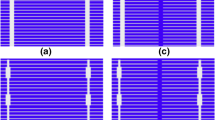Abstract
This paper presents the application of topology optimization (TO) for designing the front electrode patterns for solar cells. Improving the front electrode design is one of the approaches to improve the performance of the solar cells. It serves to produce the voltage distribution for the front surface such that the current flow through the solar cell is maximized. In this paper, we use TO to design the front electrode pattern for side-contact and pin-up modules. Specific challenges include the nonlinearity of the physical problem and the design-dependent photocurrent loading. The greater design freedom of TO versus traditional shape optimization generates novel, efficient electrode patterns. In addition, we study the effect of mesh resolution and solar cell size on the final design. The results suggest that TO can probably be an effective method to generate designs which could lead to improved performance of the solar cells.



















Similar content being viewed by others
References
Antonini A, Stefancich M, Vincenzi D, Malagu C, Bizzi F, Ronzoni A, Martinelli G (2003) Contact grid optimization methodology for front contact concentration solar cells. Sol Energ Mat Sol C 80:155–166
Bendsøe MP (1989) Optimal shape design as a material distribution problem. Struct O 1(4):193–202
Bruns TE, Tortorelli DA (2001) Topology optimization of nonlinear elastic structures and compliant mechanisms. Comput Method Appl M 190:3443–3459
Buhl T, Pedersen CBW, Sigmund O (2000) Stiffness design of geometrically non-linear structures using topology optimization. Struct Multidiscip O 19(2):93–104
Burgers AR, Bultman JH, Tip AC, Sinke WC (2001) Metallisation patterns for interconnection through holes. Sol Energ Mat Sol C 65:347–353
Conti M (1981) Optimal design of front-contact metallization for photovoltaic solar cells. Solid State Electron 24:79–83
Darrigol O (2000) Electrodymanics from Ampere to Einsteiń. Oxford University Press, USA
Ebong A, Hilali M, Upadhyaya V, Rounsaville B, Ebong I, Rohatgi A (2005) High efficiency screen-printed planar solar cells on single crystalline silicon materials. In: 31st IEEE Phot Spec Conf, IEEE Explore, pp 1173–1176
Edwards PP, Porch A, Jones MO, Morgan DV, Perks RM (2004) Basic material physics of transparent conducting oxides. Dalton T 19:2995–3002
Flat A, Milnes AG (1979) Optimization of multi-layer front-contact grid patterns for solar cells. Sol Energy 23:289–299
Galagan Y, Coenen EWC, Abbel R, van Lammeren TJ, Sabik S, Barink M, Meinders ER, Andriessen R, Blom PWM (2013) Photonic sintering of inkjet printed current collecting grids for organic solar cell applications. Org Electron 14:38–46
Gao T, Zhang WH, Zhu JH, Xu YJ, Bassir D (2008) Topology optimization of heat conduction problem involving design-dependent heat load effect. Finite Elem Anal Des 44:805–813
Gersborg-Hansen A, Sigmund O, Haber RB (2005) Topology optimization of channel flow problems. Struct Multidiscip O 30:181–192
Gersborg-Hansen A, Bendsøe MP, Sigmund O (2006) Topology optimization of heat conduction problems using the finite volume method. Struct Multidiscip O 31:251–259
Green MA (1981) Solar Cells: Oper Princ Tech Sys Appl. Prentice Hall
Gupta DK, Langelaar M, Barink M, Van Keulen F (2014) Topology Optimization: An effective method for designing front metallization patterns of solar cells. In: Proceedings, 40th IEEE Phot Spec Conf
Hughes TJR (2000) The Finite Element Method: Linear static and dynamic finite element. Dover Publ
Hyun-Jun S, Jeonghoon Y (2012) Texturing design for a light trapping system using topology optimization. IEEE T Magn 48(2):227–230
Jog CS (1997) Distributed-parameter optimization and topology design for nonlinear thermoelasticity. Comput Method Appl M 132:117–134
Otomori M, Yamada T, Izui K, Nishiwaki S, Kogiso N (2014) Level set-based topology optimization for the design of light-trapping structures. IEEE T Magn 50(2)
Petersson J, Borrvall T (2003) Topology optimization of fluids in Stokes flow. Int J Numer Meth Fl 41:77–107
Rozvany GIN, Zhou M, Birker T (1992) Aims, scope, methods, history and unified terminology of computer-aided topology optimization in structural mechanics. Struct O 4:250–252
Sigmund O (2000) Topology optimization: a tool for the tailoring of structures and materials. Philos T R Soc A 358:211–227
Sigmund O (2001) Design of multiphysics actuators using topology optimization - Part I: One-material structures. Comput Method Appl M 190:6577–6604
Sigmund O (2007) Morphology-based black and white filters for topology optimization. Struct Multidiscip O 33:401–424
Svanberg K (1987) The method of moving asymptotes - a new method for structural optimization. Int J Numer Meth Eng 24:359–373
van Deelen J, Barink M, Klerk L, Voorthuijzen P, Hovestad A (2014a) Efficiency loss prevention in monolithically integrated thin film solar cells by improved front contact. Prog Photovoltaics
van Deelen J, Klerk LA, Barink M, Rendering H, Voorthuijzen P, Hovestad A (2014b) Improvement of transparent conducting materials by metallic grids on transparent conductive oxides. Thin Solid Films 555:159–162
van Keulen F, Haftka RT, Kim NH (2005) Review of options for structural design sensitivity analysis. Part 1: linear systems. Comput Method Appl M 194:3213–3243
Wang C, Shuangcheng Y, Chen W, Sun C (2013) Highly efficient light trapping structure design inspired by natural evolution. Sci Rep 3
Weeber AW, Kinderman R, Tool CJJ, Granek F, De Jong PC (2006) How to achieve 17 % cell efficiencies on large back-contacted MC-SI solar cells. In: Proceedings, IEEE 4th World Conf Photovol Ener Conv, Hawaii, pp 1–4
Wen L, Yueqiang L, Jianjun C, Yanling C, Xiaodong W, Fuhua Y (2010) Optimization of grid design for solar cells. J Semicond 31:1–4
Acknowledgements
The authors would like to acknowledge the support of Royal Dutch Shell, NWO and FOM. We are grateful to Prof. K. Svanberg for the MATLAB subroutine of MMA and Sanne van den Boom and Richard Heemskerk for their contributions.
Author information
Authors and Affiliations
Corresponding author
Rights and permissions
About this article
Cite this article
Gupta, D.K., Langelaar, M., Barink, M. et al. Topology optimization of front metallization patterns for solar cells. Struct Multidisc Optim 51, 941–955 (2015). https://doi.org/10.1007/s00158-014-1185-9
Received:
Revised:
Accepted:
Published:
Issue Date:
DOI: https://doi.org/10.1007/s00158-014-1185-9




